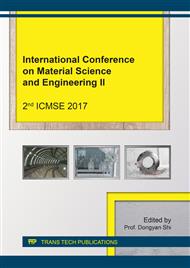[1]
E. P. Lee, Z. M. Peng, W. Chen, S. Chen, H. Yang, and Y. Xia. Electrocatalytic Properties of Pt Nanowires Supported on Pt and W Gauzes, ACS Nano. 2(10) (2008) 2167–2173.
DOI: 10.1021/nn800458p
Google Scholar
[2]
T. G. Hyeon, S. J. Han, Y. E. Sung, K. W. Park and Y. W. Kim, High-Performance Direct Methanol Fuel Cell Electrodes using Solid-Phase-Synthesized Carbon Nanocoils, Angew. Chem. Int. Ed. 42 (2003) 4352-4356.
DOI: 10.1002/anie.200250856
Google Scholar
[3]
R. Q. Yu, L. W. Chen, Q. P. Liu, J. Y. Lin, K. L. Tan, S. C. Ng, H. Chan, G. Q. Xu, T. S. Andyhor, Platinum Deposition on Carbon Nanotubes via Chemical Modification, Chem. Mater. 10 (1998) 718-722.
DOI: 10.1021/cm970364z
Google Scholar
[4]
S. Liao, K. A. Holmes, H. Taprailis, V. I. Birss, High Performance PtRuIr Catalysts Supported on Carbon Nanotubes for the Anodic Oxidation of Methanol, J. Am. Chem. Soc. 128 (2006) 3504.
DOI: 10.1021/ja0578653
Google Scholar
[5]
T. Y. Jeon, K. S. Lee, S. J. Yoo, Y. H. Cho, S. H. Kang and Y. E. Sung, Effect of Surface Segregation on the Methanol Oxidation Reaction in Carbon-Supported Pt−Ru Alloy Nanoparticles, Langmuir, 26 (2010) 9123-9129.
DOI: 10.1021/la9049154
Google Scholar
[6]
S. Yamazaki, M. Yao, Z. Siroma, T. Ioroi, and K. Yasuda. New-Concept CO-Tolerant Anode Catalysts Using a Rh Porphyrin-Deposited PtRu/C, J. Phys. Chem. C, 114 (2010) 21856-21860.
DOI: 10.1021/jp107887x
Google Scholar
[7]
S. Sharma, A. Ganguly, P. Papakonstantinou, X. Miao, M. Li, J. L. Hutchison, M. Delichatsios, and S. Ukleja, Rapid Microwave Synthesis of CO Tolerant Reduced Graphene Oxide-Supported Platinum Electrocatalysts for Oxidation of Methanol, J. Phys. Chem. C, 114 (2010).
DOI: 10.1021/jp107872z
Google Scholar
[8]
E. Antolini, E. R. Gonzalez, Ceramic materials as supports for low-temperature fuel cell catalysts, Solid State Ionics. 180 (2009) 746–763.
DOI: 10.1016/j.ssi.2009.03.007
Google Scholar
[9]
C. V. Subban, Q. Zhou, A. Hu, T. E. Moylan, F. T. Wagner, F. J. DiSalvo, Sol−Gel Synthesis, Electrochemical Characterization, and Stability Testing of Ti0. 7W0. 3O2 Nanoparticles for Catalyst Support Applications in Proton-Exchange Membrane Fuel Cells, J. Am. Chem. Soc. 132 (2010).
DOI: 10.1021/ja1074163
Google Scholar
[10]
S. Y. Huang, P. Ganesan, S. Park, B. N. Popov, Development of a Titanium Dioxide-Supported Platinum Catalyst with Ultrahigh Stability for Polymer Electrolyte Membrane Fuel Cell Applications, J. Am. Chem. Soc. 131 (2009) 13898–13899.
DOI: 10.1021/ja904810h
Google Scholar
[11]
S. E. Jang, H. Kim, Effect of Water Electrolysis Catalysts on Carbon Corrosion in Polymer Electrolyte Membrane Fuel Cells, J. Am. Chem. Soc. 132 (2010) 14700-14701.
DOI: 10.1021/ja104672n
Google Scholar
[12]
K. A. N. Quoc, T. T. Huynh, V. T. T. Ho, Preparation and characterization of indium doped tin oxide (ITO) via a non-aqueous sol-gel, Molecul. Cryst. Liq. Cryst. 635 (2016) 1-8.
DOI: 10.1080/15421406.2016.1200920
Google Scholar
[13]
K. A. N. Quoc, V. T. T. Ho, Preparation and Characterization of Indium Doped Tin Oxide (ITO) via a Solvothermal Method, J. Envir. Sci. Eng. B 5: 7 (2016) 379-384.
DOI: 10.17265/2162-5263/2016.08.001
Google Scholar
[14]
K. A. N. Quoc, T. T. Huynh, V. T. T. Ho, Preparation and Characterization of Fe/Sio2 Nanoparticles Composite via Sol-Gel and Chemical Reduction Method, Int. J. Adv. Eng. Res. Sci. 3 (2016) 45-49.
Google Scholar
[15]
V. T. T. Ho, Synthesis and Characterization of PtRuMo/C Ternary Nanoelectrocatalysts for Direct Methanol Fuel Cells, Int. J. Adv. Eng. Res. Sci. 3(5) (2016) 110-114.
Google Scholar
[16]
V. T. T. Ho, T. P. Dinh, Advanced nanostructure Ti0. 7In0. 3O2 support enhances electron transfer to Pt: Used as high performance catalyst for oxygen reduction reaction, Molecul. Cryst. Liq. Cryst. 635 (2016) 25-31.
DOI: 10.1080/15421406.2016.1200916
Google Scholar
[17]
M. Pourbaix, Atlas of Electrochemical Equilibria in Aqueous Solutions; NACE International: Houston, (1974).
Google Scholar
[18]
M. Aryanpour, R. Hoffmann, F. J. DiSalvo, Tungsten-Doped Titanium Dioxide in the Rutile Structure: Theoretical Considerations, Chem. Mater. 21 (2009) 1627-1635.
DOI: 10.1021/cm900329k
Google Scholar
[19]
H. Zhang, Y. Wang, E. R. Fachini, C. R. Cabrera, Electrochemically Codeposited Platinum/Molybdenum Oxide Electrode for Catalytic Oxidation of Methanol in Acid Solution, Electrochem. Solid-State Lett. 2 (1999) 437-439.
DOI: 10.1149/1.1390863
Google Scholar
[20]
G. Chen, Zh. Wang, D. Xia, Electrochemically codeposited palladium/molybdenum oxide electrode for electrocatalytic reductive dechlorination of 4-chlorophenol, Electrochem. Commun. 6(3) (2004) 268–272.
DOI: 10.1016/j.elecom.2003.12.011
Google Scholar
[21]
A. Chen, P. Holt-Hindle. Platinum-Based Nanostructured Materials: Synthesis, Properties, and Applications, Chem. Rev. 110 (2010) 3767–3804.
DOI: 10.1021/cr9003902
Google Scholar
[22]
F. J. Lai, L. S. Sarma, H. L. Chou, D. G. Liu, C. A. Hsieh, J. F. Lee, B. J. Hwang, Architecture of Bimetallic PtxCo1−x Electrocatalysts for Oxygen Reduction Reaction As Investigated by X-ray Absorption Spectroscopy, J. Phys. Chem. C, 113 (2009).
DOI: 10.1021/jp903105e
Google Scholar
[23]
C. C. Shih, J. R. Chang, Pt/C stabilization for catalytic wet-air oxidation: Use of grafted TiO, J. Catal. 240 (2006) 137-150.
DOI: 10.1016/j.jcat.2006.03.019
Google Scholar


